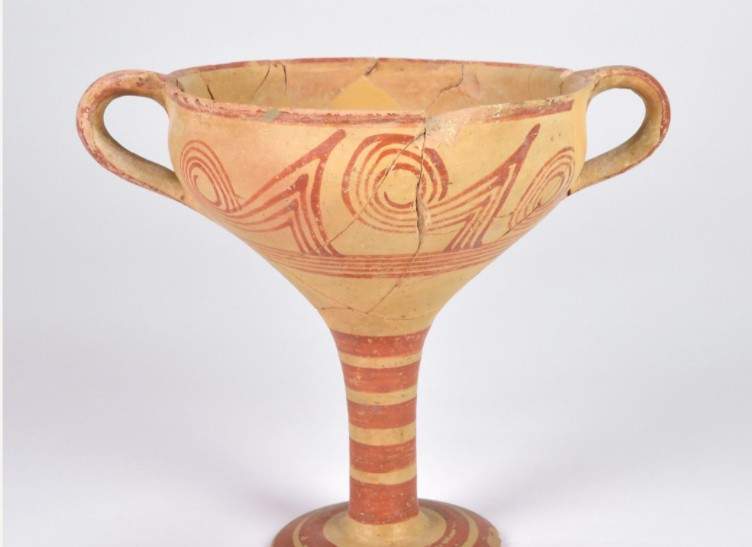From November 26, 2021 to April 30, 2022, the MIC in Faenza will host the exhibition Gioia di ber, which aims to tell the story of the uses and customs of drinking from classical antiquity to the present, then dedicated to wine and water ceramics in Italy from classical antiquity to 20th-20th century design. Through two hundred pieces from the MIC’s collections, the ceramic forms of drinking from the Greek, Etruscan and Roman worlds to contemporary design developments will be seen, analyzing their use in the conviviality of the table and linking the use of wine and water ceramics to the social contexts developed by each era to understand the elements of originality and continuity.
“Drinking and eating in company refers to aspects of sharing proper to human nature,” stresses exhibition curator Valentina Mazzotti, "which necessarily reverberate on the ceramic types adopted, often peculiar to certain cultures, but also recurring through the centuries. This is the case of the mug, the ceramic form par excellence deputed to mix liquids, derived from theoinochoe of the Greek world, which during the Middle Ages and the Renaissance takes on morphological characteristics often peculiar to the various territorial areas, standardized later in solutions of popular matrix, which have found a new interpretation in the design of the 20th century."
The works in the exhibition span four sections that offer a journey through the centuries under the banner of conviviality and ceramic forms related to drinking. The esspoitive journey starts fromclassical antiquity, present a wide variety of ceramic vessels related to the consumption of wine, such as the amphora for carrying it, the crater and oinochoe for serving it, the kylix, skyphos and kantharos for drinking it.
The ceramics from the Middle Ages to the eighteenth century show the morphological predominance of the jug, with its typical conformation with a handle as opposed to a pourer, which registers formal and decorative variations peculiar to the various spheres over the centuries. A greater articulation of fashions is noted with the turn of the “whites” of Mannerist and Baroque matrix between the 16th-17th centuries, as evidenced by the thematic in-depth study devoted to the cups “a deception” (or “drink if you can”) and other table tricks of bizarre and composite shape, aimed at arousing amazement and joy during the banquet.
Alongside the cultured and sumptuous expressions are the 18th-20th century ceramics of popular use that document the daily life of a humble and peasant society through different types of pottery (amphora, jug, pitcher, flask, flask) designed for specific needs of daily and domestic use.
The exhibition concludes with 20th-20th century design, with the ritualization of traditional types in the direction of the “new” and “contemporary” through objects designed for their functionality, their artistic expressiveness, and their being part of a new conviviality. There will be an in-depth look at current design with a focus on Manifattura Bitossi on the centenary of its founding and on new designers (Anastasio, Bubani, Formafantasma, Iacchetti, Salmistraro).
The exhibition, curated by Valentina Mazzotti conservator of the MIC in Faenza, has the collaboration of Giuseppe Sassatelli, Andrea Gaucci and Anna Gamberini of the Alma Mater Studiorum - University of Bologna for classical antiquity and Daniela Lotta of the ISIA in Faenza for design. It has contributions from the Directorate General for Education, Research and Cultural Institutes, the Emilia Romagna Region, the Municipality of Faenza - Unione della Romagna Faentina, Caviro, Ravenna Chamber of Commerce, and the patronage of Iter Vitis Les Chemin de la Vigne Cultural Itinerary of the Council of Europe, European Route of Ceramics, Casa Artusi.
For more info: www.micfaenza.org
Hours: Tuesday to Friday 10 a.m. to 2 p.m.; Saturday, Sunday and holidays 10 a.m. to 5:30 p.m. Closed on non-holiday Mondays, December 25 and January 1.
Tickets: Full 10 euros, reduced 7 euros, reduced 5 euros for Faentines.
Image: Painted cup with bands and hooked spirals (Late Minoan IIIA - IIIB, ca. 14th-13th centuries BCE).
 |
| Joy of ber: MIC in Faenza dedicates an exhibition to the customs and traditions of drinking from antiquity to the present day |
Warning: the translation into English of the original Italian article was created using automatic tools. We undertake to review all articles, but we do not guarantee the total absence of inaccuracies in the translation due to the program. You can find the original by clicking on the ITA button. If you find any mistake,please contact us.